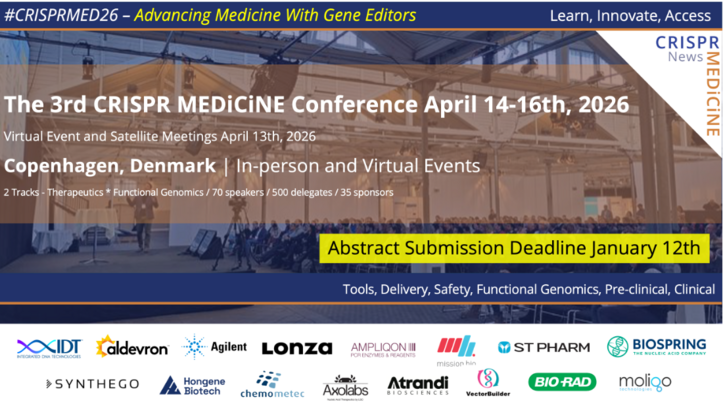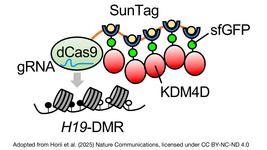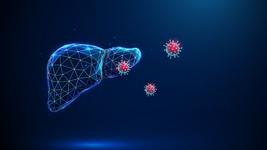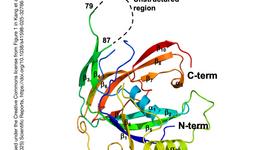CMN Weekly (16 May 2025) - Your Weekly CRISPR Medicine News
By: Gorm Palmgren - May. 16, 2025
Top picks
- Using directed evolution, David Liu and co-workers have enhanced a CRISPR-associated transposase system to create evoCAST, enabling efficient, RNA-guided gene integration in human cells. EvoCAST achieves 10–30% targeted integration without double-strand breaks, supports >10 kb payloads, and retains high precision and product purity. It offers a mutation-agnostic therapeutic approach for loss-of-function diseases and broad utility in gene therapy, immunoengineering, and synthetic biology.
- The programmable CRISPR-Cas-like bridge recombinase, IS622, enables targeted human genome insertion, inversion, and excision without requiring recognition sites. Through RNA and protein engineering, the system reached up to 20% insertion efficiency and 82% specificity. It mediated megabase-scale rearrangements and scarless removal of regulatory or repeat elements, with therapeutic potential demonstrated for BCL11A and Friedreich's ataxia targets.
Research
- A not-yet peer-reviewed study by Excision BioTherapeutics shows that multiplex CRISPR-Cas9 editing using SaCas9 and HBV-targeting gRNAs in primary human hepatocytes and mouse models effectively degraded HBV DNA, reduced viral biomarkers, and suppressed random HBV integration. Non-viral mRNA delivery limited structural alterations while avoiding chromosomal translocations. These findings support transient, multiplex gene editing as a potential strategy to eliminate HBV cccDNA and mitigate hepatocellular carcinoma risk.
- Pharmacological co-inhibition of DNA-PK and PolΘ enhances precision in multiple prime editing systems, including PE3, PE5, PE7, PEn, and dual pegRNA platforms like TwinPE. This approach reduces unintended by-products such as indels and template duplications across diverse loci and edits while also improving PEn's off-target profile – demonstrating that DNA repair modulation is a broadly effective strategy for refining prime editing fidelity.
- Cas12h, a type V-H CRISPR effector, functions as a crRNA-guided DNA nickase that selectively cleaves the non-target strand of double-stranded DNA due to its narrow RuvC catalytic pocket. Structural and biochemical studies revealed high specificity and metal-dependent activity. Engineered as an adenine base editor, Cas12h achieved efficient A-to-G editing in bacteria, offering promise for precise, low-toxicity genome editing applications.
- Suppressing single-strand annealing (SSA) alongside non-homologous end joining improves CRISPR knock-in accuracy by reducing imprecise repair patterns, including asymmetric homology-directed repair. Long-read sequencing revealed that SSA inhibition limits nucleotide deletions and donor misintegration more effectively than targeting microhomology-mediated end joining. These results suggest SSA modulation as a promising strategy to enhance precise endogenous tagging.
- Imprecise DNA repair hinders CRISPR-mediated knock-in precision. A Japanese study shows that, beyond inhibiting NHEJ, blocking SSA and MMEJ pathways reduces deletions at cut sites and boosts HDR accuracy. SSA inhibition specifically suppresses asymmetric HDR and disintegration events. These findings reveal the overlapping roles of DSB repair pathways and support SSA inhibition as a strategy to enhance CRISPR-based tagging fidelity.
ASGCT 2025
- Precision BioSciences is advancing PBGENE-DMD, an in vivo ARCUS-based gene editing therapy targeting exon 45–55 deletions in Duchenne muscular dystrophy. Preclinical data show durable dystrophin restoration and functional muscle improvement, including in satellite stem cells. With IND/CTA submission planned for 2025 and clinical data expected in 2026, Precision is prioritising this programme while pausing its mitochondrial disease candidate to conserve resources.
- AIRNA presented preclinical data showing that its lead RNA editing candidate, AIR-001, achieves >50% in vivo editing of the PiZ mutation, causing alpha-1 antitrypsin deficiency (AATD). Using its RESTORE+ platform, AIRNA restored functional M-AAT protein, improved disease biomarkers, and showed no toxicity in primates. With subcutaneous GalNAc delivery and strong safety and efficacy, AIRNA plans a clinical trial application in late 2025.
- Excision BioTherapeutics presented preclinical data showing that EBT-107, a CRISPR therapy for hepatitis B, effectively reduces viral biomarkers and suppresses HBV DNA integration without inducing chromosomal translocations. Separately, EBT-104, targeting latent HSV-1 in keratitis, nearly eliminated ocular viral shedding and reduced latent DNA via dual-guide AAV9-delivered CRISPR. Both programmes support the feasibility of one-time gene editing treatments for chronic viral infections.
- Editas Medicine reported preclinical data showing its targeted LNP platform achieved up to 48% HBG1/2 promoter editing in HSCs in vivo, surpassing the therapeutic threshold for upregulating fetal haemoglobin. Using AsCas12a, the approach mimics fetal haemoglobin to treat sickle cell disease and beta thalassaemia. The liver-detargeted delivery system enables efficient, one-dose HSC editing, supporting progression toward a transformative in vivo therapeutic.
- Editas Medicine presented in vivo proof-of-concept data for a CRISPR-Cas-based therapy targeting an undisclosed liver gene. LNP-delivered editing mimicked a protective variant, achieving ~70% liver editing in mice, with >80% biomarker reduction. In primate hepatocytes, editing exceeded 50% with >15-fold protein upregulation. These results support a potential first-in-class therapy with clinical candidate and target disclosure expected later in 2025.
- MaxCyte presented five posters at ASGCT 2025 showcasing advances in non-viral CRISPR-based engineering for CAR T cells and virus-like particles (VLPs). Using its ExPERT™ electroporation platform, MaxCyte achieved high-efficiency CAR knock-ins, scalable GMP VLP production, and effective delivery of transposon systems. SeQure DX, a MaxCyte company, detailed robust CRISPR guide design pipelines and SAFER Detection™, a sensitive assay for identifying chromosomal rearrangements critical for safe therapeutic genome editing.
- Integra Therapeutics announced two oral presentations at ASGCT showcasing its FiCAT gene-writing platform with double-digit editing efficiencies for next-generation cell therapies. The first presentation demonstrates CAR-T cell creation expressing complex CARs in a single DNA donor; this approach simplifies production and shows improved elimination of B-cell acute lymphoblastic leukaemia (B-ALL) tumour cells and autoimmune B cells versus market leaders. The second presents CAR-T cells generated using novel CRISPR-Cas12l nucleases combined with FiCAT through Integra's partnership with Caszyme, demonstrating better efficiency than CRISPR-Cas9.
Industry
- pharmaphorum reports about a wave of recent biotech layoffs, underscoring the sector's mounting financial strain, with firms across modalities slashing headcounts to conserve capital. The cuts – ranging from 20% to 95% – reflect ongoing investor caution, shifting priorities toward clinical validation, and stalled partnerships. Even well-capitalised companies are retrenching, signalling broader instability as biotechs recalibrate to survive in a capital-constrained and increasingly data-driven environment.
- Eligo Bioscience has secured a $5M French government grant to scale its CRISPR-based topical gene delivery platform, enabling in situ therapeutic biologic production by skin-resident bacteria. Building on acne-targeting base editing, the funding supports clinical progression, Biose Industries partnership, and expansion into immuno-dermatology, leveraging microbiome engineering for localised immune modulation in chronic skin diseases.
- Stylus Medicine, co-founded by CRISPR-Cas scientist Patrick Hsu, is developing in vivo genetic therapies using engineered recombinases for precise gene insertion. Backed by $85 million, the biotech combines therapeutic-grade recombinases, large nucleic acid payloads, and targeted LNP delivery to address gene editing limitations. Its approach enables length-independent, scarless genome integration—highlighting a shift from platforms to product-focused genetic medicine.
- Sangamo Therapeutics priced a $23 million underwritten offering, selling common stock and pre-funded warrants bundled with six-year exercisable warrants at $0.50 and $0.49, respectively. Proceeds will support general operations as Sangamo advances its neurology-focused pipeline and Fabry gene therapy. This capital raise aims to extend runway into Q3 2025 amid ongoing business development efforts.
- Synthego has launched GMP-grade SpCas9, expanding its CRISPR portfolio with a unified, cGMP-compliant solution for therapeutic development. Bundled with GMP sgRNAs and supported by regulatory documentation, the offering streamlines IND-enabling workflows, enhances consistency and scalability, and reduces regulatory complexity – positioning Synthego as a key enabler of clinical-stage CRISPR gene editing.
- Editas Medicine announced that the U.S. Court of Appeals partially vacated and remanded the CRISPR-Cas9 patent interference case involving UC/Charpentier and the Broad Institute back to the PTAB. While unrelated to its Cas12a IP, which remains unaffected, Editas reaffirmed confidence in its extensive CRISPR patent portfolio and licensing strategy and anticipates a favourable outcome supporting its foundational rights in CRISPR-based human therapeutics.
- Beam Therapeutics has received FDA RMAT designation for BEAM-302 to treat alpha-1 antitrypsin deficiency (AATD). This LNP-delivered base editing therapy corrects the PiZ mutation in the SERPINA1 gene, restoring functional AAT production and reducing toxic aggregates. Early clinical data show durable, dose-dependent correction and protein restoration, supporting its potential as a one-time, curative treatment for both liver and lung manifestations of AATD.
- Ensoma has achieved FDA IND clearance for a Phase 1/2 trial starting in late 2025 with EN-374. The therapy uses CRISPR-mediated gene insertion via virus-like particles to restore CYBB expression in neutrophils for treating X-linked chronic granulomatous disease. Preclinical data showed restored NADPH oxidase activity, supporting EN-374 as a potential one-time, in vivo alternative to stem cell transplantation or ex vivo editing approaches.
- The global CRISPR market, valued at $2.9B in 2024, is projected to reach $5.47B by 2030, driven by demand for gene therapies, research tools, and industrial applications. CRISPR kits and enzymes dominate, with pharma and biotech firms as major users. Services like gRNA synthesis are growing rapidly. North America leads, while Asia Pacific sees substantial expansion in biotech research and healthcare.
Q1 2025 financial results and business updates
- Verve Therapeutics reported promising Phase 1b data for VERVE-102, its in vivo base editor targeting PCSK9, showing up to 69% LDL-C reduction with strong safety. Phase 2 dosing is planned for late 2025. Verve also progresses VERVE-201 (ANGPTL3) for refractory and homozygous familial hypercholesterolaemia and VERVE-301 (LPA) for lipoprotein(a) reduction, with updates expected in H2 2025. The company's cash runway extends into mid-2027.
- Sangamo Therapeutics reported Q1 progress centred on its neurology-focused pipeline and Fabry gene therapy. A new AAV capsid deal with Lilly could yield up to $1.4B, while its Fabry programme reached key milestones toward a 2026 BLA. ST-503 for chronic pain is set to enter the clinic in mid-2025. Cost-cutting measures have extended runway into Q3 2025, as Sangamo continues to seek a Fabry commercial partner.
- Prime Medicine is advancing liver-targeted Prime Editors for AATD and Wilson's disease, with IND filings expected in 2026. Preclinical AATD data showed high on-target editing and complete M-AAT restoration. Initial CGD clinical data for PM359 is anticipated in 2025. With $158.3m in cash, the company projects runway into H1 2026 as it pushes toward first-in-human validation of prime editing's therapeutic potential.
- Precision BioSciences reported strong Q1 progress, advancing PBGENE-HBV for chronic Hepatitis B and accelerating PBGENE-DMD for Duchenne muscular dystrophy, both using its ARCUS platform. Early safety and functional data support clinical potential, with INDs planned in 2025. The company deprioritised its mitochondrial programme to focus resources, maintaining a cash runway into H2 2026 to support Phase 1 readouts for its two lead in vivo gene editing therapies.
- Fate Therapeutics reported Q1 progress on FT819, its off-the-shelf iPSC-derived CAR T-cell therapy for lupus. This therapy received FDA RMAT designation and will expand to other B cell-driven autoimmune diseases. Additional Phase 1 data will be presented at EULAR in June. With $273M in cash, the company is advancing multiple CAR T and NK cell candidates, targeting solid tumours and autoimmune disorders, with an operating runway into H1 2027.
- Editas Medicine reported Q1 progress on two in vivo gene upregulation programmes targeting HSCs and liver, both showing strong preclinical efficacy. Using AsCas12a and lipid nanoparticles, the HBG1/2 programme reached therapeutically relevant editing in NHPs, while an undisclosed liver target showed >80% biomarker reduction in mice. With $221M in cash and runway into Q2 2027, Editas plans to declare both development candidates in mid-2025.
- Cellectis reported Q1 progress on its TALEN-based allogeneic CAR T programmes, lasme-cel and eti-cel, with Phase 1 data readouts expected in H2 2025. At ASGCT, the company presented novel non-viral gene insertion and TALE base editing (TALEB) data, showing improved precision and efficiency. Development continues under its AstraZeneca partnership, spanning CAR T therapies and in vivo gene editing for genetic disease.
- Allogene Therapeutics reported steady progress in its allogeneic CAR T pipeline, with key trials advancing in lymphoma (ALPHA3, cema-cel), autoimmune disease (RESOLUTION, ALLO-329), and renal cancer (TRAVERSE, ALLO-316). Enrollment momentum and international expansion are bolstering ALPHA3. Proof-of-concept updates for ALLO-329 are now expected in H1 2026. Cost realignment has extended the company's cash runway into H2 2027, supporting its prioritised programmes through major clinical inflection points.
Detection
- A CRISPR-Cas12a-driven biosensor enables trimodal detection – electrochemical, fluorescence, and UV–vis – of miRNA at femtomolar levels. Target-induced R-LAMP activates Cas12a to cleave hairpin probes on methylene blue-loaded nanocarriers. The multimodal readout offers rapid, self-validating analysis within 70 minutes, matching RT-qPCR performance in real samples. This tri-mode system holds strong potential for accurate early-stage cancer diagnostics.
Reviews
- CRISPR-Assisted Probiotic and In Situ Engineering of Gut Microbiota: A Prospect to Modification of Metabolic Disorders. This review aims to explore and discuss the possibilities of CRISPR-Cas and the current trends in using this technique for editing gut microbiota genes in various metabolic disorders.
News from CRISPR Medicine News
- On Thursday, we broke the news of the world's first mRNA-based, patient-specific CRISPR therapy for an infant with a lethal metabolic disorder – developed and delivered within just six months of diagnosis. The treatment, targeting carbamoyl phosphate synthetase 1 (CPS1) deficiency, was administered under a single-patient emergency protocol, and following two intravenous infusions, the neonate patient's condition improved considerably.
- On Wednesday, we presented the latest clinical trial updates, including FDA RMAT designation to Beam Therapeutics' BEAM-302 for the treatment of alpha-1 antitrypsin deficiency and an IND clearance issued to Ensoma for its lead programme EN-374 in chronic granulomatous disease.
- Monday saw a CMN Special featuring Dr. Cecilia Jimenez-Mallebrera from Barcelona's Sant Joan de Déu Pediatric Hospital. She is a pioneer in CRISPR-Cas9 applications for muscular dystrophies and biomarker discovery, and she discussed how CRISPR-based therapies are now advancing to human trials, offering new hope for patients despite ongoing challenges in safe delivery to skeletal muscle.
The news item covering Integra Therapeutics' ASGCT presentations was inadvertently omitted from our May 16th edition and was included retrospectively on 2th June 2025.
To get more CRISPR Medicine News delivered to your inbox, sign up to the free weekly CMN Newsletter here.
Tags
ArticleMissing linksNewsCMN WeeklyFamilial Hypercholesterolemia, FHEnsomaIntima Bioscience, Inc.Scribe TherapeuticsYolTech Therapeutics
CLINICAL TRIALS
IND Enabling
Phase I
Phase II
Phase III
Gastric Cancer and Colorectal Cancer, CRC, (NCT07166263)
Sponsors:
Base Therapeutics (Shanghai) Co., Ltd.
Sponsors:
Base Therapeutics (Shanghai) Co., Ltd.
IND Enabling
Phase I
Phase II
Phase III
Relapsed or Refractory Acute Myeloid Leukemia, AML, (NCT06541444)
Sponsors:
Base Therapeutics (Shanghai) Co., Ltd.
Sponsors:
Base Therapeutics (Shanghai) Co., Ltd.
IND Enabling
Phase I
Phase II
Phase III







